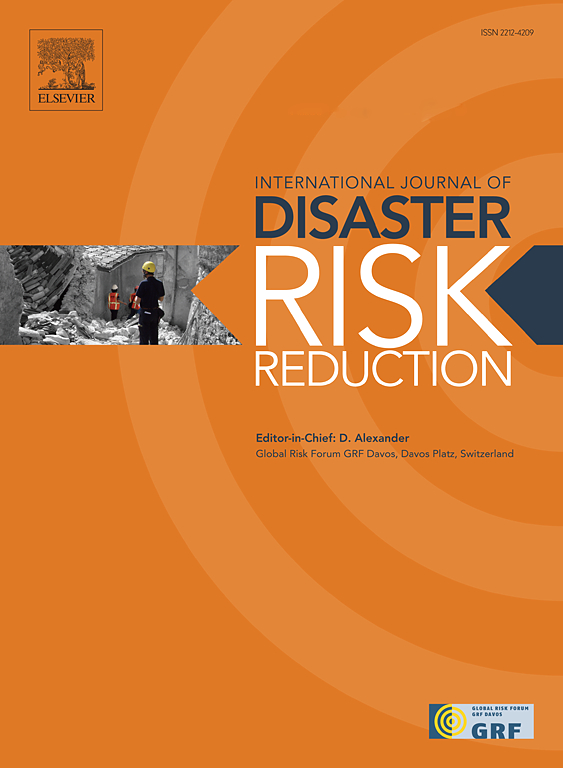Barriers and best practices for inclusive emergency alerts and warnings
IF 4.2
1区 地球科学
Q1 GEOSCIENCES, MULTIDISCIPLINARY
International journal of disaster risk reduction
Pub Date : 2025-05-16
DOI:10.1016/j.ijdrr.2025.105581
引用次数: 0
Abstract
Recent disasters showed major gaps in emergency alerting––the process of sending emergency information to communities rapidly–where people with limited-English proficiency (LEP) and auditory or visual (AV) disabilities experience issues receiving alerts in their preferred language or formats. In this paper, we review academic literature, agency reports, and news articles to synthesize barriers and develop best practices for inclusive alerting. The barriers identified include: (1) lack of capacity from agencies distributing alerts and warnings; (2) delay or lack of information in multiple languages; (3) channels used to distribute information are often inaccessible; (4) inaccurate translations; (5) lack of trust in government authorities; and (6) communities’ lack of familiarity with U.S.-based hazards and various cultural beliefs. Despite the barriers, the literature also identifies a series of recommendations that can be summarized into six best practices: alerting authorities should (1) participate in regular training in cultural competency and how to communicate with diverse audiences; (2) actively involve diverse community partners in the process of alert dissemination; (3) distribute alerts via multiple channels; (4) avoid jargon, use plain language, and translate the meaning of alerts; (5) disseminate alerts via well-informed, trusted sources and incorporate participation of diverse populations and communities; (6) and tailor communication to diverse populations and communities by developing language access plans. We present actionable recommendations and considerations for alerting authorities. We anticipate that alerting authorities, researchers, and decision makers can use these findings to improve inclusivity of alerts and warnings for all communities.
包容性紧急警报和警告的障碍和最佳做法
最近发生的灾难表明,在紧急警报————迅速向社区发送紧急信息的过程————方面存在重大差距,在这些地方,英语水平有限的人和视听残障人士在接收以其首选语言或格式发出的警报时遇到了问题。在本文中,我们回顾了学术文献、机构报告和新闻文章,以综合障碍并开发包容性警报的最佳实践。确定的障碍包括:(1)分发警报和警告的机构缺乏能力;(2)延迟或缺乏多语言信息;(3)用于传播信息的渠道往往无法进入;(4)译文不准确;(5)对政府机关缺乏信任;(6)社区对美国的灾害和各种文化信仰缺乏熟悉。尽管存在障碍,但文献也确定了一系列建议,这些建议可以总结为六个最佳实践:提醒当局应(1)参加文化能力和如何与不同受众沟通的定期培训;(2)在警报传播过程中,积极动员社会各界伙伴参与;(3)多渠道发布警报;(4)避免行话,使用通俗易懂的语言,并翻译警报的意思;(5)通过消息灵通、可靠的来源传播警报,并吸收不同人群和社区的参与;(6)通过制定语言获取计划,为不同的人群和社区量身定制交流。我们提出了可操作的建议和注意事项,以提醒当局。我们预计警报当局、研究人员和决策者可以利用这些发现来提高警报和警报对所有社区的包容性。
本文章由计算机程序翻译,如有差异,请以英文原文为准。
求助全文
约1分钟内获得全文
求助全文
来源期刊

International journal of disaster risk reduction
GEOSCIENCES, MULTIDISCIPLINARYMETEOROLOGY-METEOROLOGY & ATMOSPHERIC SCIENCES
CiteScore
8.70
自引率
18.00%
发文量
688
审稿时长
79 days
期刊介绍:
The International Journal of Disaster Risk Reduction (IJDRR) is the journal for researchers, policymakers and practitioners across diverse disciplines: earth sciences and their implications; environmental sciences; engineering; urban studies; geography; and the social sciences. IJDRR publishes fundamental and applied research, critical reviews, policy papers and case studies with a particular focus on multi-disciplinary research that aims to reduce the impact of natural, technological, social and intentional disasters. IJDRR stimulates exchange of ideas and knowledge transfer on disaster research, mitigation, adaptation, prevention and risk reduction at all geographical scales: local, national and international.
Key topics:-
-multifaceted disaster and cascading disasters
-the development of disaster risk reduction strategies and techniques
-discussion and development of effective warning and educational systems for risk management at all levels
-disasters associated with climate change
-vulnerability analysis and vulnerability trends
-emerging risks
-resilience against disasters.
The journal particularly encourages papers that approach risk from a multi-disciplinary perspective.
 求助内容:
求助内容: 应助结果提醒方式:
应助结果提醒方式:


